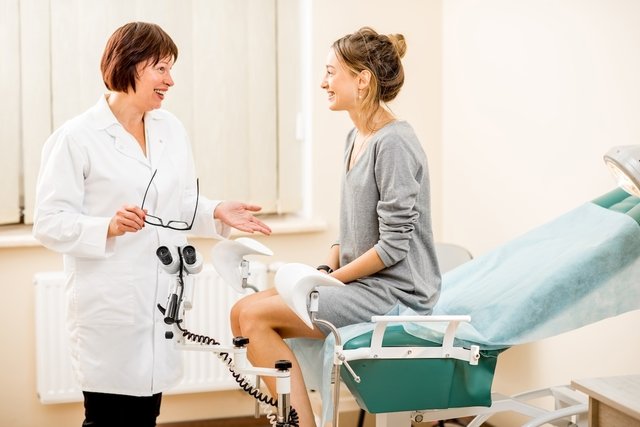Ovarian pain is a symptom that may arise due to ovulation, which occurs around the 14th day of the cycle, when the egg is released by the ovary into the Fallopian tube, and is not a cause for concern. However, ovarian pain may also be related to a health condition, such as endometriosis, ovarian cyst or pelvic inflammatory disease.
Depending on its cause, ovarian pain may be accompanied by other symptoms such as bleeding outside of the menstrual period, pain or burning when urinating, or pain that radiates to the back. In some cases, such as ovarian torsion or ectopic pregnancy, the pain may appear suddenly and cause nausea or vomiting.
It is important to consult a gynecologist when ovarian pain is frequent or when it is accompanied by other symptoms, so that tests can be carried out to identify the cause and carry out the most appropriate treatment. In the case of ovarian torsion and ectopic pregnancy, you should seek emergency room immediately.

Main causes of ovarian pain
The main causes of ovarian pain are:
1. Ovulation
Some women may experience pain at the time of ovulation, which occurs around the 14th day of the menstrual cycle, when the egg is released by the ovary into the fallopian tubes. This ovarian pain, also known as Mittelschmerz or intermenstrual pain, can be mild to intense and last a few minutes or even hours and can be accompanied by slight bleeding and in some cases the woman may also feel nauseated.
If this pain is very intense, or lasts for several days, it may be a sign of diseases such as endometriosis, ectopic pregnancy or the presence of ovarian cysts.
What to do: Treatment is generally not necessary for pain caused by ovulation, however, if the discomfort is severe it may be necessary to take painkillers such as paracetamol, or anti-inflammatories such as ibuprofen or speak to your doctor to start taking contraceptives. See the main contraceptives that may be recommended by your doctor.
Don’t ignore the signs your body is giving you!
2. Ovarian cyst
An ovarian cyst is a fluid-filled sac that can form in or around the ovary and can cause pain during ovulation and intimate contact, delayed menstruation, increased breast sensitivity, vaginal bleeding, weight gain or difficulty getting pregnant. Know how to identify all the symptoms of ovarian cysts.
What to do: The ovarian cyst usually decreases in size without requiring treatment. However, if this does not happen, the cyst can be treated with the use of contraceptive pills or even surgery that involves removing it. If the cyst is very large, shows signs of cancer or if the ovary is torsion, it may be necessary to completely remove the ovary. See all treatment options for ovarian cysts.
3. Ovarian Torsion
The ovaries are attached to the abdominal wall by a thin ligament, through which blood vessels and nerves pass. Sometimes this ligament can end up bending or twisting, which causes intense and constant pain that does not improve.
Ovarian torsion is more common when there is an ovarian cyst, as the ovaries become larger and heavier than normal.
What to do: Ovarian torsion is an emergency situation, so if very intense and sudden pain appears, it is important to go to the emergency room to identify and start appropriate treatment.
4. Endometriosis
Endometriosis can be another cause of ovarian pain, which consists of the growth of endometrial tissue outside its normal location, such as outside the uterus, ovaries, bladder, appendix or even intestines.
Thus, endometriosis can cause symptoms such as intense pain in the belly that can radiate to the lower back, pain after intimate contact, pain when urinating and defecating, heavy bleeding during menstruation, difficulty getting pregnant, diarrhea or constipation, tiredness , nausea and vomiting. Know how to identify all the symptoms of endometriosis.
What to do: The treatment of endometriosis must be carried out under the guidance of a gynecologist, who may recommend the use of contraceptive pills or hormone IUDs, or anti-hormonal medications, such as goserelin or danazol. Furthermore, the doctor may recommend surgery, which consists of removing the endometrial tissue located outside the uterus, in order to reduce symptoms and enable pregnancy. See how endometriosis surgery and recovery are performed.
5. Pelvic inflammatory disease
Pelvic inflammatory disease (PID) is an inflammation that originates in the vagina and progresses, affecting the uterus, tubes and ovaries, spreading over a large pelvic area, leading to ovarian pain, yellowish or greenish vaginal discharge with bad smell, pain during intimate contact or fever.
Pelvic inflammatory disease occurs in most cases as a consequence of a sexually transmitted infection (STI) that has not been properly treated, such as gonorrhea or chlamydia, but it can also arise due to infection at the time of birth, introduction of contaminated objects into the vagina during masturbation or endometriosis, for example.
What to do: The treatment of pelvic inflammatory disease is done with the use of antibiotics prescribed by the gynecologist, such as azithromycin, levofloxacin or clindamycin, for example, in tablet or injection form. Furthermore, the treatment must also be carried out by the partner and intimate contact must be avoided during treatment. See the main treatments for pelvic inflammatory disease.
6. Ectopic pregnancy
Ectopic pregnancy occurs when the embryo develops outside the uterus, being most common in the fallopian tubes, also called uterine tubes, but it can also occur in the ovary, cervix, abdominal cavity, causing symptoms such as ovarian pain, intense colic on just one side of the belly and worsens with movement.
Pain caused by ectopic pregnancy is usually accompanied by other symptoms such as vaginal bleeding, pain during intimate contact, dizziness, nausea, vomiting or fainting.
What to do: You should go to the nearest emergency room immediately so that tests can be carried out, confirm the diagnosis and begin the most appropriate treatment, which is usually done through surgery to remove the embryo. Find out how ectopic pregnancy is treated.
7. Ovarian cancer
Ovarian cancer is a malignant tumor that can affect one or both ovaries and that in the early stages does not cause signs or symptoms, however, as it develops, the woman may experience ovarian pain, pelvic pain, bleeding outside of her period. menstrual period, swollen belly or feeling of a full stomach, constipation or diarrhea, or frequent tiredness.
Ovarian cancer is most common in women aged between 50 and 70 years, however, it can appear at any age, especially in women who have a family history of ovarian or breast cancer.
What to do: You should consult a gynecologist to carry out tests, diagnose ovarian cancer and begin the most appropriate treatment, which can be done with surgery to remove the affected ovary, chemotherapy or radiotherapy, for example. See all treatment options for ovarian cancer.
8. Remnant ovarian syndrome
Remnant ovarian pain is a rare condition that can arise after oophorectomy or salpingo-oophorectomy surgery, which is the removal of one or both ovaries, caused by remnants of ovarian tissue that were not completely removed during surgery.
Generally, incomplete removal of ovarian tissue occurs due to the presence of adhesions in the ovary, intense bleeding during surgery or even the surgical technique used.
What to do: Treatment must be carried out under the guidance of a gynecologist, who may recommend further surgery to remove the remaining remains of the ovary, or hormone replacement therapy, when surgery is not indicated.



